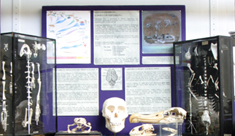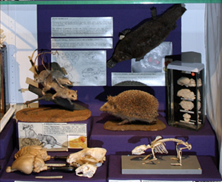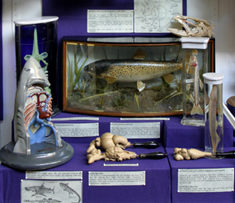
PHYLUM CHORDATA | ||||||||||||||||||||||||||||||||||||||||||||||||||
Living members of the phylum Chordata include four types of vertebrate chordates belonging to the subphylum Vertebrata – fish, amphibians, birds and mammals - and three types of invertebrate chordates – cephalochordates, urochordates and hagfish (subphylum Myxini, class Myxini). The hagfish, fish, amphibians, birds and mammals are displayed in the Aubrey Manning Gallery. The cephalochordates and urochordates are displayed with the other invertebrate animals. | ||||||||||||||||||||||||||||||||||||||||||||||||||
SUBPHYLUM VERTEBRATA
Vertebrate chordates, like invertebrate chordates, have a notochord or fibrous supporting rod; metameric segmentation; a hollow nerve cord lying above the notochord; gills and a post-anal tail. Their vertebrate characteristics are: an internal skeleton of cartilage or bone, which includes a vertebral column enclosing the notochord; a brain enclosed in a skull; a dorsal nerve cord; a pumping heart and efficient blood circulation. Adults may lack some chordate features but embryos still have gill pouches, segments and a post-anal tail. The specimens in the two introductory cases show the distinguishing morphological features, including brain structure, of the seven classes of living vertebrates. Around 37800 living vertebrate species have been identified to date. Class Cephalaspidomorphi: The lampreys (jawless fish)Class Chondrichthyes: The jawed cartilaginous fish Class Osteichthyes: The jawed bony fish Class Amphibia: Amphibians Class Reptilia: Reptiles Class Aves: Birds Class Mammalia: Mammals The amphibians, reptiles, birds and mammals have bony skeletons and are called tetapods because they have four limbs based on a pentadactyl (five-fingered) plan. The evolution of this type of limb helped vertebrates to invade land. The jawed vertebrates (jawed fish and tetrapods) are sometimes placed together in the superclass Gnathostomata. Other vertebrate specimens are arranged within a taxonomic framework to illustrate the great diversity of animals within each class. | ||||||||||||||||||||||||||||||||||||||||||||||||||
| ||||||||||||||||||||||||||||||||||||||||||||||||||













